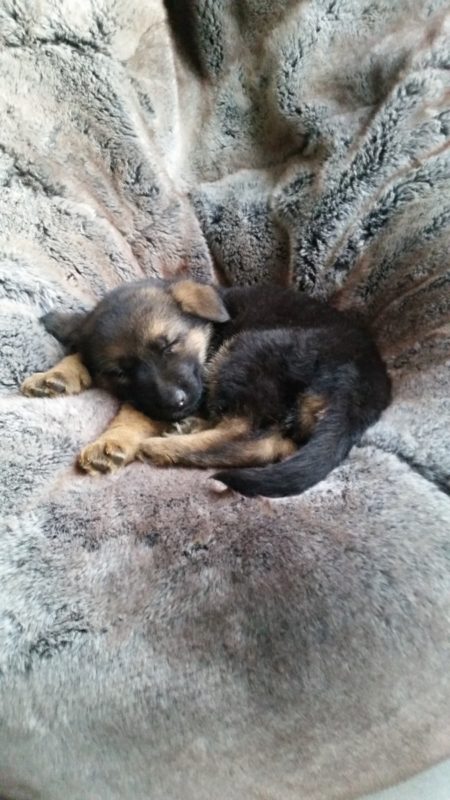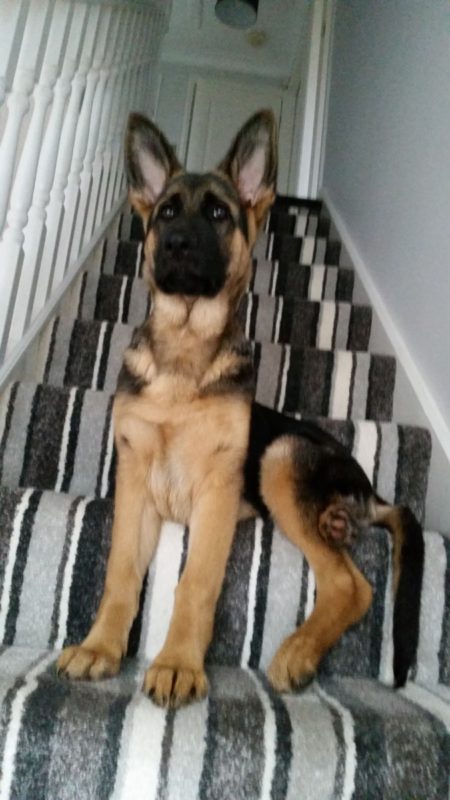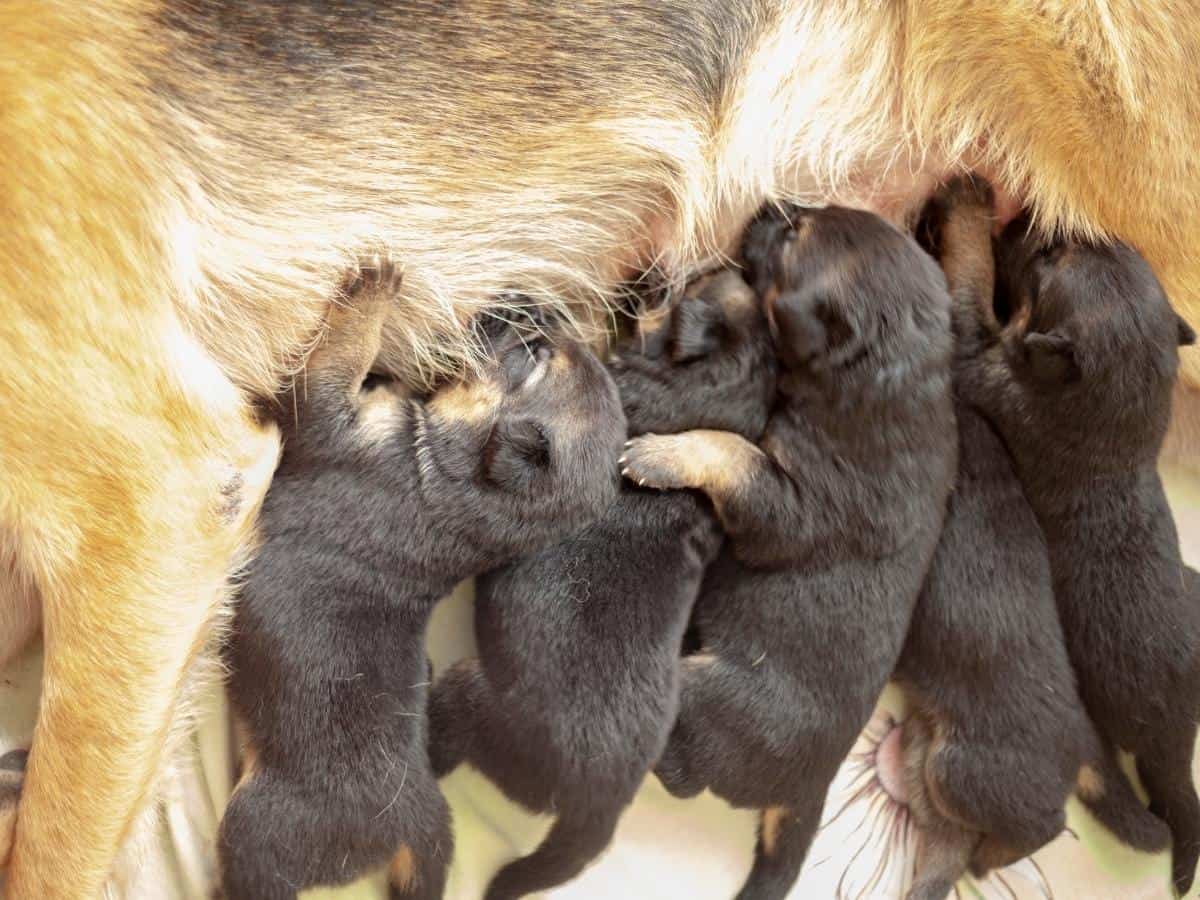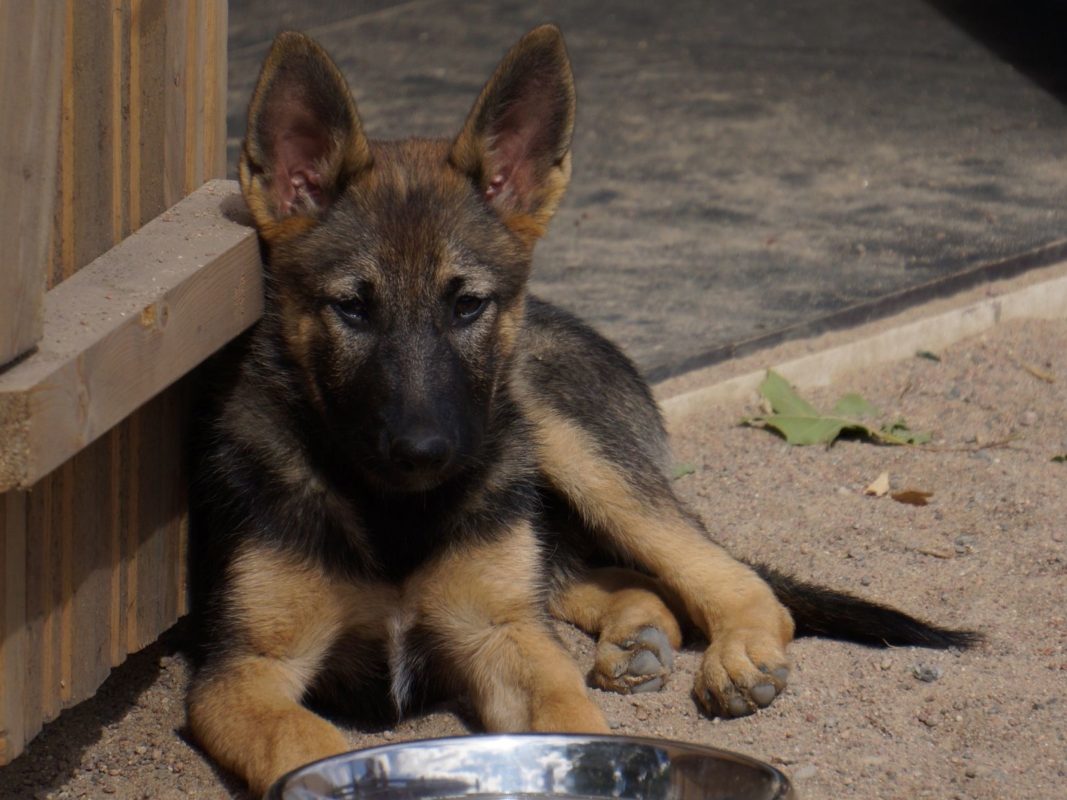From early puppyhood to adulthood, German Shepherds undergo significant development that shapes their temperament, behavior, and physical abilities. As a dog owner, understanding the developmental stages of your German Shepherd is crucial to providing the right care and training.
German Shepherd development consists of several stages. The first two stages involve a mother’s presence, and the next two consist of improvement in social cognition and hierarchy-setting. After that, your puppy will learn what’s normal, develop public etiquette, and become physically stronger.
In this article, we will explore the different aspects of German Shepherd development, including their physical, cognitive, and social growth, and provide insights into how you can support your furry friend’s journey toward becoming a well-rounded and happy dog.


Please note that this post isn’t a replacement for a training guide, though an article on German Shepherd training is available here.
But if you came to this article wanting to know how your German Shepherd develops from birth to 2 years old, you won’t be disappointed. Let’s begin!
German Shepherd Development and Growth Stages
German Shepherd development refers to the physical, cognitive, and social changes that occur in German Shepherd puppies as they grow and mature into adulthood.
These changes include the physical development of their muscles, bones, and organs, as well as their ability to learn and process information. Social development involves their ability to interact with other dogs and humans and to understand and follow social rules and norms.
As a dog owner, it is important to understand the growth stages of your German Shepherd. Knowing what to expect during each stage can help you provide the best care for your furry friend.
Birth to Two Weeks – Complete Dependence on the Mother
This is a stage where you shouldn’t even be dealing with a GSD puppy unless you’re a breeder (in which case you’ll not need this information) or have a family dog who has given birth. In the latter case, you need to know that the German Shepherd puppy depends on his mother for everything in these initial weeks.
This includes food, warmth, and physical security. Removing a German Shepherd from his mother’s company can have a two-fold traumatic impact as it hurts both the mother dog and the puppy.
Here, your only responsibility is to make sure the dam is equipped with what she needs to fulfill her duties.
As long as you feed the adult GSD right, she will be able to feed her babies and give them the warmth and company they need. You might notice that the puppies may seem asocial.
This shouldn’t be a cause for concern as German Shepherd puppies do not start socializing until later weeks within their formative months. Do not measure how the puppy interacts with other dogs for at least three to four weeks, which brings us to what you can expect within the next two weeks.
2 to 4 Weeks – Weaning Off
You can start expecting your GSD puppy to become semi-independent of his mother in the third week. This is where the puppy can wean off and not need a diet made up of milk exclusively. The puppy can consume solid food but is not too fond of it, especially if it is strange in texture.
Do not be over-cautious of the “healthiness” of food at this stage, as whatever you feed him here is not the diet he will maintain all the way to adulthood. Your priority at this stage should be to get him to accept solid food without regressing to a diet of milk.
There will be a social incentive in weaning off as the puppy will observe the litter he belongs to and notice a simultaneous change in feeding preferences.
This brings us to a very important change: social interaction. While the German Shepherd puppy isn’t a social casanova at this stage, he starts interacting with other puppies by the fourth week.
I mentioned above that you should not worry about social disinterest up until the third week. However, by the fourth week, you should look for some interaction.
If the puppy fails to acknowledge others in the litter or is getting shunned collectively, consulting an expert trainer or a vet can be helpful.
In case you don’t have access to a professional getting a breeder’s opinion can also help. Breeders are masters of raising puppies to the age of 8 weeks because that’s usually the stage where most pups are adopted, though some will release puppies at 7 weeks (not recommended).

4 to 5 Weeks – Accepting Human Guardianship
This is where human interference starts becoming prominent but is still a stage you shouldn’t be concerned with unless you didn’t spay your German Shepherd and she’s given birth. Otherwise, the journey from being 4 weeks old to being adoption-ready is a long one, and it starts by accepting a human guardian.
From weeks 4 to 5, the puppy is learning to accept a human (usually the breeder) as his guardian. The human’s responsibility here is to get the puppy vaccinated as soon as possible and establish himself as the guiding figure.
Please note that breeders aren’t legally required to vaccinate puppies so if yours isn’t vaccinated at 8 weeks, move forward with his vaccination process as soon as possible.
It’s good that a puppy isn’t outside a breeder’s custody at the guardianship acceptance stage because novices end up taking the word “dominant” too literally and try to position themselves as dominant guardians.
Both dominant guardian and guiding guardian archetypes work in establishing yourself as the leader, but the dominant frame might box you into less palatable training tactics.
It is hard to maintain your “position” as the stern guardian and be positive and loving. However, if you’ve established yourself as an assertive yet caring guardian, you can give positive reinforcement-based training without worrying about losing your status.
Check Out This Cool YouTube Video on the Stages of Puppy Development…
5 to 8 Weeks – Indoor Socializing
Socializing with the guardian is the first step in a cognitive leap. German Shepherd puppies are quite intelligent, but a bulk of this cognitive ability is unlocked in two stages.
The first is around the five-week mark. This could be the fourth or sixth week, depending on the individual puppy, but it is noticeable when the dog starts getting excited about other dogs.
Of course, you need to be on schedule with socialization and carry-walks to notice this. Remember that “carry-walks” are for long distances, and you have to get your puppy to walk short distances around this time.
If the puppy you adopt hasn’t been in an environment with other dogs while his social cognition was developing, he might never get grounding in the canine norms and be “too weird” for other dogs. Again, this explains why breeders usually keep the GSD puppies at this stage.
“Canine social awkwardness is different from human social awkwardness. This isn’t about teenage acne and fashion-consciousness. It is about not learning how to receive other dogs’ energy.”
World of Dogz
In weeks 5 to 8, your German Shepherd puppy is usually learning how to show excitement in an acceptable way and how to perceive other dogs’ energy. Aggression issues can stem from excitement signaling menace.
If your German Shepherd’s excitement is taken as a threat by other dogs, he might be shunned or even attacked. The opposite is true as well. If your puppy cannot see other dogs’ excitement as anything but aggression, he might decide that offense is the best defense.
Fortunately, professional breeders expose the dog to other dogs his age at this stage, and he learns to adjust how he shows and perceives excitement, making your life as a new German Shepherd parent much easier. But socializing your German Shepherd happens in stages as well.
8 to 16 Weeks – Improvement in Social Cognition
You usually receive your new German Shepherd at this stage. When your German Shepherd is 8 weeks old, he’s developed enough to begin making distinctions between human demographics. That’s why it is wise to get him well-acquainted with people from different backgrounds. And of different ages.
The wider the variety of people he gets to see and interact with at this stage, the more receptive he will be to people growing up. Remember, German Shepherds are huge as adults, and nurturing gentle giants is essential for everyone’s safety.
To learn exactly how to socialize your German Shepherd from pup to adult, head over to this article, 7 Easy Ways To Socialize a German Shepherd.
If your German Shepherd has seen only young people all his life, he might react differently to older ones and vice versa. You don’t want to wait until he is 2 years old to learn that he isn’t too fond of kids or senior citizens.
This also applies to experiences. Exposing your puppy to experiences like car rides and ringing doorbells ensures that he will be calm in normal situations as he grows up. It’s easy to dismiss a little GSD puppy getting over-excited at a doorbell, but wait until he’s fully grown, and you’ll wish you had gotten him “bell-trained!”
Bell-trained isn’t an actual term, but “crate training” is. And in addition to getting your German Shepherd acquainted with normal stimuli like bells and travel, you must get him crate trained at this stage.
Introducing the crate as a refuge and a secure spot as opposed to jail is a great way to get your GSD puppy to accept the crate. The more you delay this, the harder it becomes to crate-train a German Shepherd.
Remember, whether it is ringing the doorbell to neutralize your puppy’s response or it is getting him to accept his crate, you’re engineering what your dog sees as normal. That’s why you can see this stage as the “normal-defining” moment in your German Shepherd’s development.
Not a lot of training happens during your puppy’s first week in his new home, and if you refer to my German Shepherd puppy training schedule, you’ll see that the pup will learn to follow you around during this week. If you don’t get in the way, your doggo will train himself to see you as his guardian.
During this development phase, your German Shepherd’s fast physical growth will not go unnoticed. If you want to check how his growth compares to the guidelines, head over to this article, When Do German Shepherds Stop Growing? This also includes a handy growth chart.
4 to 6 Months – Status Recognition Among Peers
While the previous few weeks are all about noticing and accepting the norms as a pet, this phase of your German Shepherd’s development is all about finding his normal spot in the canine hierarchy.
This is a critical stage because if unchecked, your German Shepherd might end up hurting other dogs or be hurt by them. The watchful dog-parent in you that you were holding back has his chance to shine here.
Read More: Are German Shepherds Aggressive?
Make sure you keep a close eye on your German Shepherd and how he interacts with any other dogs in the house. The status-measuring step is one even adult dogs take when first interacting with each other. But at this age, dogs engage in prolonged status-measuring inquiry and either establish dominance or accept their subservient spot.
You cannot force your German Shepherd to be the alpha in a relationship with another dog. Let them sort their hierarchy naturally and just make sure there’s no physical harm. GSDs are very physical, which is fine when two dogs play within the same breed.
But if one of your doggos belongs to a relatively fragile lineage, you might want to consider some separation. If you are worried your German Shepherd playing too rough, click the link for some cool tips on how to limit rough play.

6 to 12 Months – Cognitive Stabilization
From 6 months onwards, your German Shepherd is pretty much cognitively developed and has the mental foundation to receive advanced outdoor social training. From walking etiquette to how they act upon encountering another person or dog, your German Shepherd’s behavior in public places matters.
The easier to walk your GSD is, the more enjoyable it will be for you both. Still, you must consider that your dog’s growth caps are still open, so you should not let him run too much or jump from higher places. This is better elaborated in my dedicated post on the fun exercises you can do with your German Shepherd puppy.
Your German Shepherd’s cognitive development is stabilizing, and you’re educating him in public place etiquette. At the same time, his physical energy levels are rising every day, which can be counterproductive as your German Shepherd can get uber-excited about physical activity.
Make sure you have him on a no-pull harness instead of a collar-and-leash, so you can get him properly under control without hurting him. I use the Walk Your Dog With Love No-pull Harness as it prevents your dog’s natural instinct to pull as it leads from the front, unlike rear-attached harnesses. You can also see my other recommendations here.
1 to 2 Years – Physical Growth and Adulthood
This is the stage where your German Shepherd is fully developed in the cognitive sense, and all that remains is his physical growth. Your German Shepherd’s growth plates are open until around the 18-month mark when they become a stable part of the bone.
Nonetheless, I’d recommend still waiting another 6 months six months before your dog can safely jump and run long distances, especially on hard surfaces.
Until then, walk him on a leash as much as possible and make sure you control his speed. German Shepherds aren’t experts in German Shepherd biology, and between you and your dog, you’re the only one who can read this post. Therefore, it is your responsibility to keep him from hurting himself by dampening his excitement, especially when you’re outside.
The latter six months of this period are all about maintenance. Your job is to maintain your German Shepherd’s stamina and keep up his feeding schedule. The rest is all about routine setting.
Whatever routine is set here is the one that you will both follow after this point. Make sure you factor in your own convenience alongside your dog’s interests to have a healthy, fulfilled relationship with him for years to come.
Final Thoughts
A German Shepherd puppy’s development occurs in stages, first cognitively and then physically. As long as you ensure minimal interference in the first few weeks, promote socializing and guidance reception during the middle, and physical stamina and restraint in the final stages before adulthood, your dog will be an easy-to-manage charmer who will win hearts and get along with others.





